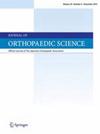Analysis of cancer multigene panel testing for osteosarcoma in pediatric and adults using the center for cancer genomics and advanced therapeutics database in Japan
IF 1.4
4区 医学
Q3 ORTHOPEDICS
引用次数: 0
Abstract
Background
Osteosarcoma (OS) is the most common primary malignant bone tumor. Despite advances in multimodal chemotherapy, prognosis for metastatic or recurrent OS remains poor. Next-generation sequencing (NGS) can uncover new therapeutic options by identifying potentially targetable alterations. This study analyzed NGS data from the Center for Cancer Genomics and Advanced Therapeutics (C-CAT) database in Japan, comparing findings with the Memorial Sloan–Kettering-Integrated Mutation Profiling of Actionable Cancer Targets (MSK-IMPACT) data from the United States.
Methods
We sequenced tumor and/or germline DNA from 223 high-grade OS samples using the FoundationOne® CDx or OncoGuideTM NCC Oncopanel System, and the FoundationOne® Liquid CDx for multigene panel testing (2019–2023). Genomic alterations were interpreted using the Cancer Knowledge Database (CKDB), with potentially actionable genetic events categorized into A-F levels.
Results
Analysis of 223 high-grade OS samples revealed 1684 somatic mutations in 167 genes and 1114 copy number alterations in 89 genes. Potentially actionable alterations were identified in 94 patients (42.2 %) at CKDB Levels A-C. These included 2 cases with NTRK fusions (0.9 %; Level A), one case with TMB-high (0.4 %; Level A), 3 with ERBB amplifications (1.3 %; Level B), and 88 cases (39.5 %) with alterations such as CDK4 amplification, PTEN deletion/mutation, and others (Level C). Co-occurring amplifications of KIT, KDR, and PDGFRA at the 4q12 locus were found in 8 cases (3.6 %), while VEGFA and CCND3 co-amplifications at the 6p12-21 locus were seen in 33 cases (14.8 %). These gene amplifications, also reported in US studies, are targetable by multi-kinase inhibitors, although the C-CAT cohort's profiles differed from US cohorts like MSK-IMPACT.
Conclusions
Precision medicine for rare tumors still poses challenges. In this Japanese cohort, 42.2 % of high-grade OSs had potentially actionable alterations per CKDB. Concurrent gene amplifications of KIT, KDR, and PDGFRA at 4q12, and VEGFA and CCND3 at 6p12-21, might offer promising therapeutic options for patients with recurrent/metastatic OS resistant to conventional chemotherapy.
利用日本癌症基因组学和先进治疗学中心数据库,对儿童和成人骨肉瘤的癌症多基因面板检测进行分析。
背景:骨肉瘤(Osteosarcoma,OS)是最常见的原发性恶性骨肿瘤。尽管多模式化疗取得了进展,但转移性或复发性骨肉瘤的预后仍然很差。下一代测序(NGS)可以通过识别潜在的靶向性改变发现新的治疗方案。本研究分析了日本癌症基因组学与先进治疗中心(Center for Cancer Genomics and Advanced Therapeutics,C-CAT)数据库中的NGS数据,并将结果与美国纪念斯隆-凯特琳癌症靶点突变综合分析(Memorial Sloan-Kettering-Integrated Mutation Profiling of Actionable Cancer Targets,MSK-IMPACT)数据进行了比较:我们使用FoundationOne® CDx或OncoGuideTM NCC Oncopanel系统以及用于多基因面板检测的FoundationOne® Liquid CDx(2019-2023年)对223份高级别OS样本的肿瘤和/或种系DNA进行了测序。利用癌症知识数据库(CKDB)对基因组改变进行解读,并将潜在的可操作基因事件分为A-F级:结果:对223份高级别OS样本的分析显示,167个基因中有1684个体细胞突变,89个基因中有1114个拷贝数改变。在CKDB A-C级的94名患者(42.2%)中发现了潜在的可操作改变。其中包括 2 例 NTRK 融合(0.9%;A 级),1 例 TMB-高(0.4%;A 级),3 例 ERBB 扩增(1.3%;B 级),以及 88 例(39.5%)CDK4 扩增、PTEN 缺失/突变等改变(C 级)。8例(3.6%)患者在4q12位点发现KIT、KDR和PDGFRA的共存扩增,33例(14.8%)患者在6p12-21位点发现VEGFA和CCND3的共存扩增。这些基因扩增在美国的研究中也有报道,虽然C-CAT队列的情况与MSK-IMPACT等美国队列不同,但多激酶抑制剂可以靶向治疗这些基因扩增:结论:罕见肿瘤的精准医疗仍面临挑战。在这个日本队列中,42.2%的高级别OS发生了CKDB潜在的可操作改变。4q12处的KIT、KDR和PDGFRA基因以及6p12-21处的VEGFA和CCND3基因的同时扩增可能为对常规化疗耐药的复发性/转移性OS患者提供有希望的治疗选择。
本文章由计算机程序翻译,如有差异,请以英文原文为准。
求助全文
约1分钟内获得全文
求助全文
来源期刊

Journal of Orthopaedic Science
医学-整形外科
CiteScore
3.00
自引率
0.00%
发文量
290
审稿时长
90 days
期刊介绍:
The Journal of Orthopaedic Science is the official peer-reviewed journal of the Japanese Orthopaedic Association. The journal publishes the latest researches and topical debates in all fields of clinical and experimental orthopaedics, including musculoskeletal medicine, sports medicine, locomotive syndrome, trauma, paediatrics, oncology and biomaterials, as well as basic researches.
 求助内容:
求助内容: 应助结果提醒方式:
应助结果提醒方式:


